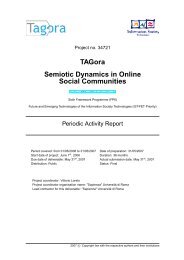NoiseTube: Measuring and mapping noise pollution with mobile ...
NoiseTube: Measuring and mapping noise pollution with mobile ...
NoiseTube: Measuring and mapping noise pollution with mobile ...
You also want an ePaper? Increase the reach of your titles
YUMPU automatically turns print PDFs into web optimized ePapers that Google loves.
The blue curve on figure 5 shows the response of the microphone compared<br />
to a sound level meter. According to this result this phone can be<br />
used as a sound level meter in the interval [35, 100 dB] due to the curve‟s<br />
bijectivity. After applying the inverse function as a post-processing corrector<br />
we obtained results <strong>with</strong> a final precision of ± 4 dB (red line).<br />
5.2 Positioning accuracy<br />
Using the Nokia N95 8GB <strong>with</strong> its built-in GPS chip an acceptable level of<br />
positioning accuracy in outdoor situations can be achieved. Errors are<br />
rarely bigger than 30 meters, which is still good enough to localise <strong>noise</strong><br />
sources <strong>with</strong>in a specific neighbourhood or street. When using an external<br />
GPS receiver positioning accuracy can be slightly improved <strong>and</strong> the startup<br />
time is generally shorter. Using an external receiver also has the added<br />
benefit that the phone's battery life is less affected. However, in both cases<br />
indoor positioning is virtually impossible.<br />
6. Discussion <strong>and</strong> future work<br />
Democratisation of technologies such as <strong>NoiseTube</strong> will bring new applications<br />
<strong>and</strong> new questions for the participatory sensing paradigm.<br />
6.1 Roles of citizens<br />
How to sustain a human network at a larger scale <strong>and</strong> for a longer time<br />
than a local <strong>and</strong> short-term experimentation or campaign? How to design a<br />
network mixing humans <strong>and</strong> machines to monitor environmental resources?<br />
As far as we know, these questions have not been tackled yet by<br />
the current research on participatory sensing due to the small amount of<br />
participants <strong>and</strong> so the lack of complex structures. No explicit network topology<br />
has been used for the experimentation except the basic „stars‟ topology.<br />
But further investigation could take advantage of social relationships,<br />
shared interests or reputation (expert/scientist) among the<br />
participants as a solution for problems as data <strong>and</strong> analysis credibility by<br />
using them not only as sensors but also as filters or regulators.




